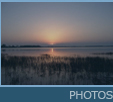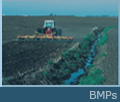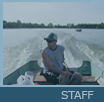        |
|
HIGH TEMPERATURES CAN BRING HARMFUL ALGAL BLOOMS .................................................................. Lake Algae And Lou Gehrig's ..................................... Algal Blooms - Most algae blooms are harmless, but some blue-green algal blooms can produce toxins that may sicken people and animals. Blue-green algae, which are actually bacteria (cyanobacteria), are found throughout Minnesota and thrive in warm, nutrient-rich lakes. Freshwater algal blooms are the result of an excess of nutrients, particularly phosphorus. When phosphates are introduced into water systems in higher concentrations they can cause increased growth of algae and plants. Algae tend to out-compete plants under these conditions, and many plant species may begin to die. This dead organic matter becomes food for bacteria that decomposes it. With more food available, the bacteria increase in number and use up the dissolved oxygen in the water. When the dissolved oxygen content decreases, many fish and aquatic insects cannot survive. This results in a hypoxic (low-oxygen) or anoxic (no oxygen) area and may result in fish kills. Algae blooms can also form scums, cakes or skins on the surface of the water that look like pea soup or thick paint. When the algae decompose they can emit high levels of hydrogen sulfide gas, which can cause temporary air quality problems and give off a very powerful “rotten egg” smell. Even though not all algal blooms are toxic, it is not possible to predict which blooms will be toxic and which will be harmless. So if the water looks "pea-soupy" or smells swampy, keep out. ..................................... For more information on harmful algal blooms, check out these resources: Factsheets & Posters : Facts about Cyanobacteria & Harmful Algal Blooms: from the Centers for Disease Control Harmful Algal Blooms in the Great Lakes: What they are and how they can affect your health - from NOAA Protect yourself from blue-green algae exposure: from Wisconsin DNR Toxic Algae Poster: from Minnesota Pollution Control Agency ..................................................................... Websites & Publications : Harmful Algae in Minnesota Lakes: When in Doubt, Stay Out!: online article from Minnesota Sea Grant, August 2008 Harmful Algae: Freshwater: webpage suitable for kids or adults, from Woods Hole Oceanographic Institute and NOAA Harmful Algae Takes Advantage of Global Warming: More Algae Blooms Expected: online article from Science Daily, April 2008 Microcystis in the Environment and Its Health Effects: Florida Fish & Wildlife Research Institute webpage on microcystis, a potentially toxic species of blue-green algae. Algae toxins spreading through air: online article from Muskegon Chronicle, December 2007 Scientists Study Link Between Zebra Mussels and Algae Blooms: Science Daily online article, September 1998 |
|
|
||
|

